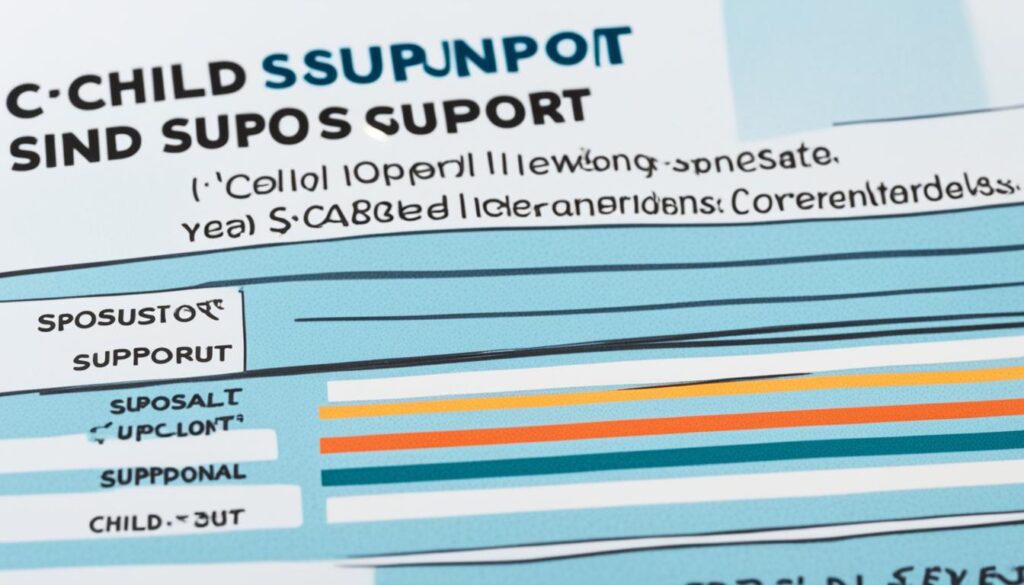Child Support and Alimony
Understanding Alimony: Reasons for Payment Obligations

Are you aware that about 12% of marriages in the United States end in divorce? Going through a divorce can be a deeply challenging and emotionally charged experience, particularly regarding finances. A critical element for those navigating a divorce to grasp is alimony, alternatively known as spousal support. Alimony refers to payments mandated by the court to be made to an ex-spouse following a divorce or separation. This financial assistance aims to support the spouse who either makes less money or has no income at all.
It is crucial to have a clear understanding of the reasons why someone may have to pay alimony, as it is determined based on various factors such as income disparity, length of marriage, contributions to the household, existing needs, and the ability to support oneself. Let’s explore the intricacies of alimony and its payment obligations to ensure a fair resolution for all parties involved.
Key Takeaways:
- Approximately 12% of marriages in the United States end in divorce.
- Alimony, also known as spousal support, is a court-ordered payment made to a former spouse after a divorce or separation.
- The purpose of alimony is to provide financial support to the spouse who earns less or has no income.
- Alimony is determined based on factors such as income disparity, length of marriage, contributions to the household, existing needs, and the ability to support oneself.
- Understanding the reasons for alimony payment obligations is crucial for individuals going through a divorce to ensure a fair resolution.
Income Disparity and Spousal Support
When it comes to determining alimony payments, income disparity plays a crucial role. If one spouse does not have a regular source of income or is not employed, they may have an advantage in receiving spousal support. Without the financial support of their partner, they may struggle to meet their financial needs on their own.
The court takes into consideration the earning capacity and financial needs of both parties when calculating the amount and duration of alimony payments. This ensures that the spouse with less income or no income at all receives the necessary support to maintain an acceptable standard of living.
In cases of income disparity, the goal of alimony payments is to bridge the financial gap between the two spouses and provide a fair and equitable solution. It acknowledges the contributions made during the marriage and helps ensure that both parties have the means to move forward after the divorce or separation.
Income disparity can significantly impact the amount and duration of alimony payments. It is important to understand this factor when navigating the complexities of spousal support, as it can have a considerable impact on the financial well-being of both parties involved.
How Income Disparity is Assessed
The court considers various factors when assessing income disparity and its effect on spousal support. These factors include:
- The difference in earning capacity between the spouses
- The standard of living during the marriage
- The financial needs of the supported spouse
- The ability of the supporting spouse to meet those needs
By carefully evaluating these factors, the court aims to ensure that both parties are treated fairly and that the supported spouse is not left in a financially vulnerable position following the divorce or separation.
Understanding the Impact
Income disparity can have significant implications for alimony payments. It can result in higher support amounts being awarded to the supported spouse, as their financial needs may be greater due to their lower income or lack of income. This ensures that they receive the necessary financial assistance to maintain their quality of life.
In cases where there is a substantial income disparity, the court may also award permanent or long-term alimony to the supported spouse. This is to compensate for the imbalance created by the income disparity and to provide ongoing financial support until the receiving spouse can become self-supporting.
The table below provides a visual representation of how income disparity can affect alimony payments:
| Income Disparity | Potential Alimony Outcome |
|---|---|
| High income disparity | Potential for higher alimony payments and longer duration |
| Moderate income disparity | Moderate alimony payments and medium-term duration |
| Low income disparity | Lower alimony payments and shorter duration |
Note: The table above is for illustrative purposes only and may not represent the specific outcome of every case. Alimony payments are determined on a case-by-case basis and depend on the unique circumstances of each situation.

Length of Marriage and Alimony
The duration of alimony payments can be influenced by the length of the marriage. In general, the longer a couple has been married, the longer the alimony payments may continue. This is because the court recognizes that a longer marriage may have created a greater level of financial interdependence between the spouses.
The newly reformed laws also take into consideration the income earned by the working spouse during the marriage. If the working spouse has significantly higher earnings during the marriage, it may result in a longer duration of alimony payments to support the spouse with lower or no income.
The court determines the ratio of alimony payments to the duration of the marriage based on various factors. These factors include the quality of the relationship, the number of years spent together, and the financial needs of the spouse receiving support. By considering these factors, the court aims to strike a fair balance between providing necessary financial assistance and promoting self-sufficiency.
It is important to note that every case is unique, and the specific duration of alimony payments will depend on the specific circumstances of the couple involved. Consulting with a family law attorney can provide further guidance on how the length of your marriage may impact alimony payments.

Alimony Duration Examples
| Length of Marriage | Alimony Duration |
|---|---|
| 5 years | 2 years |
| 10 years | 5 years |
| 20 years | 10 years |
Alimony Duration and Employment
When it comes to alimony payments, their duration is not meant to be indefinite. The court takes into consideration the qualifications and ability of the non-working spouse to support themselves. If the recipient spouse finds suitable employment, they may be required to give up their right to receive alimony.
The duration of alimony is determined based on the individual circumstances of the parties involved. This can include factors such as the length of the marriage, the financial needs of the recipient spouse, and the ability of the paying spouse to meet those needs. Additionally, changes in employment or financial situations may result in modifications to the duration of alimony payments.
It is important to understand that alimony is not a lifelong obligation. Instead, it is designed to provide temporary support to the recipient spouse as they become financially independent. The specific duration of alimony will vary case by case, and it is typically outlined in the divorce decree or settlement agreement.
The Impact of Employment on Alimony
Employment can significantly impact the duration of alimony payments. If the recipient spouse is able to secure stable employment and demonstrate their ability to support themselves financially, the court may decide to terminate or reduce the alimony amount.
The recipient spouse’s employment prospects are taken into account during the alimony determination process. If they possess the skills, qualifications, and job opportunities necessary to establish financial independence, the court may modify or terminate alimony accordingly.
However, it is essential to recognize that the decision to terminate alimony is not solely based on the recipient spouse’s employment status. Other factors, such as the length of the marriage, the financial resources of both parties, and any existing agreements, will also be considered.

Contributions to the Household and Alimony
When determining alimony, the court takes into account the contributions made by each spouse to the household. This includes financial contributions, as well as non-financial contributions such as raising children, managing the household, and supporting the career of the other spouse. The extent of these contributions can play a significant role in the determination of alimony payments.
If both spouses have made equal contributions to the household, the court may consider the amount of time spent together and the need for child support when establishing alimony payments. In such cases, the goal is to ensure a fair distribution of financial resources that supports the well-being of both parties and any children involved.
“The mutual contributions made by each spouse to the household are essential factors considered by the court when determining alimony. The financial and non-financial sacrifices made in support of the marriage are taken into consideration to ensure a fair and equitable outcome for both parties.”
However, if there is a significant difference in the contributions to the household, the spouse who has made greater contributions may be entitled to seek reimbursement or treat the money spent on the marriage as a loan. This recognizes the sacrifices made by one spouse to support the other during the marriage, and seeks to address any financial imbalances that may arise as a result of the divorce or separation.
It’s important to note that the court examines the specific circumstances of each case and considers various factors when determining alimony, including the extent and value of the contributions made by each spouse. This ensures that the financial support provided through alimony is fair and reflects the contributions and sacrifices made during the course of the marriage.

Existing Needs and Financial Resources
When determining alimony, the court takes into account the existing needs, income, and resources of each party involved. This examination helps ensure that the spouse with fewer financial resources and greater needs receives the necessary support until they can achieve financial independence.
Alimony is designed to bridge the income disparity gap and provide financial stability to the recipient spouse, particularly in cases where they may have sacrificed their career opportunities to support the marriage and family. By considering the existing needs, the court aims to maintain a reasonable standard of living for the recipient spouse.
However, it’s important to note that alimony is not an unlimited obligation. Typically, there is a specified time duration for the payments, allowing the recipient spouse ample time to secure their financial independence.
In determining alimony, the court also considers any significant changes in circumstances that may affect the financial resources of both parties. These changes could include a significant increase or decrease in income, changes in employment status, or the accumulation of significant assets.
Example:
“The court values Jennifer’s existing needs and financial resources. As a stay-at-home mom for over 15 years, she gave up her career to support the family. With minimal financial resources and no recent work experience, Jennifer requires spousal support to cover her living expenses and to invest in additional education or job training for future employment opportunities. The court recognizes the importance of providing Jennifer with the means to rebuild her financial independence in a reasonable timeframe.”
By considering the existing needs and financial resources of each party, the court endeavors to strike a balance between providing fair support to the recipient spouse and ensuring that the obligations are reasonable and achievable for the paying spouse.

Alimony Enforcement and Consequences
While child support payments have clear enforcement mechanisms, alimony is not enforced in the same way. When a supporting spouse fails to make alimony payments, the recipient spouse may need to take legal action to compel payment. This typically involves returning to court and requesting a contempt proceeding against the non-paying spouse. Such action highlights the serious consequences that can arise from failing to meet spousal support obligations.
The consequences for nonpayment of alimony can range from civil to criminal charges for the spouse in violation. Depending on the jurisdiction and the circumstances of the case, the court may impose various enforcement options to collect unpaid spousal support. These options include fines, wage garnishment, and liens on property.
“Nonpayment of spousal support can have severe repercussions. It is essential for the supporting spouse to fulfill their financial obligations to avoid legal and financial consequences.

| Enforcement Options | Potential Consequences |
|---|---|
| Fines | Financial penalties imposed by the court to incentivize compliance with alimony obligations. |
| Wage Garnishment | A legal process where a portion of the paying spouse’s wages is withheld to fulfill alimony payments. |
| Liens on Property | The court may place a lien on the non-paying spouse’s property, which can impact future property transactions. |
If the supporting spouse continues to neglect their alimony obligations despite these enforcement measures, they may face more severe consequences, including potential imprisonment for contempt of court. The court system takes the enforcement of spousal support seriously to ensure the financial stability of the recipient spouse. It is crucial for both parties involved to understand the serious repercussions of nonpayment and fulfill their financial responsibilities.
Termination of Alimony
The duration of alimony payments can vary depending on the circumstances and specific factors outlined in the divorce proceedings. Alimony, typically rehabilitative in nature, serves to provide financial support to the recipient until they can achieve self-sufficiency through educational pursuits, job training, or securing employment. However, there are several events that can trigger the termination of alimony.
One common occurrence that can bring an end to alimony payments is the death of either spouse. In the unfortunate event of a spouse’s passing, the financial obligations for alimony cease to exist. Similarly, if the recipient spouse remarries, alimony payments typically terminate. This is due to the assumption that the financial support received from a new partner should alleviate the need for continued alimony.
Additionally, the court has the authority to order the termination of alimony based on certain circumstances. If it is determined that the recipient spouse has achieved the financial independence necessary to support themselves adequately, the court may terminate the alimony obligation. This can occur when the recipient spouse secures a well-paying job, completes an education or training program, or demonstrates a significant improvement in their financial status.
In some cases, the duration and terms of alimony payments are outlined in prenuptial agreements. These agreements, entered into prior to marriage, can specify the specific duration of alimony and any conditions for its termination. If a prenuptial agreement is in place, the terms outlined within it will govern the duration and termination of alimony, overriding any default provisions determined by the court.

It is important to consult with a knowledgeable family law attorney to understand the specific termination conditions for alimony in your jurisdiction. They can guide you through the legal process and ensure that your rights and obligations are protected.
With the implementation of the Tax Cuts and Jobs Act in 2019, the tax implications of alimony payments have undergone a significant change. Previously, alimony payments were deductible for the payer and considered taxable income for the recipient. However, under the new tax law, alimony payments are no longer deductible for the payer, and the recipient does not have to pay taxes on the support received.
This change in tax treatment can have important implications for individuals involved in divorce proceedings. The payer of alimony no longer receives a tax benefit for making these payments, which could impact their overall financial situation. On the other hand, the recipient of alimony no longer needs to report the payments as income, providing some relief in their tax obligations.
It is important for individuals navigating the complexities of alimony payments to consult with a tax professional. They can provide guidance specific to one’s situation and help determine the tax implications of alimony. By understanding the tax consequences, individuals can better plan for their financial future and ensure compliance with the new tax laws.

(Note: The above image is for illustrative purposes only and may not depict the exact scenarios mentioned in this section.)
By being aware of the tax implications, both the payer and the recipient of alimony can make informed decisions about their finances and ensure they are meeting their tax obligations. It is crucial to stay updated on any changes to tax laws that may affect alimony payments, as legislation can evolve over time.
In summary, the Tax Cuts and Jobs Act has brought about significant changes to the tax treatment of alimony payments. It is important for individuals involved in divorce proceedings to understand the new tax implications and consult with a tax professional to navigate these changes effectively.
Key Points:
- Prior to 2019, alimony payments were tax deductible for the payer and taxable income for the recipient.
- Under the new tax law, alimony payments are no longer tax deductible for the payer, and the recipient does not pay taxes on the support received.
- Consulting with a tax professional is essential to understand the specific tax implications of alimony payments in one’s situation.
Conclusion
Alimony plays a crucial role in divorce proceedings by providing financial support to the lower-earning or non-earning spouse. The determination of alimony payments takes into account factors such as income disparity, length of marriage, contributions to the household, existing needs, and the ability to support oneself. It is essential for individuals undergoing a divorce to understand the reasons behind alimony obligations and the potential consequences of non-payment.
Consulting with a family law attorney can provide valuable guidance and ensure a fair resolution in alimony matters. These legal professionals specialize in navigating the complexities of alimony, helping clients understand their rights and obligations. By working closely with an attorney, individuals can gain clarity on their specific situation and achieve an equitable resolution.
In conclusion, alimony summary, it is vital to approach the issue of alimony with knowledge and a clear understanding of its purpose and implications. With the help of legal expertise, individuals can navigate the complexities of alimony and work towards a fair resolution that meets the needs of both parties involved.
Alimony, also known as spousal support, is a court-ordered payment made to a former spouse after a divorce or separation. Its purpose is to provide financial support to the spouse who earns less or has no income.
Alimony payments are determined based on factors such as income disparity, length of marriage, contributions to the household, existing needs, and the ability to support oneself.
Income disparity plays a significant role in determining alimony payments. If one spouse has no income or earns significantly less, they may be at an advantage in receiving spousal support.
The duration of alimony payments is influenced by the length of the marriage. Generally, the longer the couple has been married, the longer the alimony payments may continue. If the recipient spouse finds employment, they may be required to give up the right to receive alimony. The duration of alimony is determined based on individual circumstances and may change if there are significant changes in employment or financial situations.
The contributions of each spouse to the household are considered when determining alimony. If both parties have made equal contributions, the alimony will be based on the need for child support and the amount of time spent together.
The court considers the debts, needs, income, and resources of each party when determining alimony. The spouse with fewer financial resources and greater needs may be entitled to support until they become financially independent.
Alimony is not enforced in the same way as child support payments. If the supporting spouse fails to make alimony payments, the recipient spouse may need to return to court and request a contempt proceeding to compel payment.
Alimony can be terminated upon the death of either spouse, remarriage of the recipient spouse, or a court order. Prenuptial agreements may also dictate the duration and terms of alimony payments. With the Tax Cuts and Jobs Act, alimony payments are no longer deductible for the payer and are not considered taxable income for the recipient. It is important to consult with a tax professional to understand the specific tax implications of alimony payments.
Understanding alimony is crucial for individuals going through a divorce. It helps them grasp the reasons why they may be required to pay alimony and be aware of the potential consequences of non-payment. Consulting with a family law attorney can provide guidance and ensure a fair resolution.
FAQ
What is alimony?
How is alimony determined?
How does income disparity affect alimony payments?
How does the length of marriage affect alimony?
What happens if the recipient spouse finds employment?
How do contributions to the household affect alimony?
What factors are considered in determining alimony?
How is alimony enforced?
What leads to the termination of alimony?
What are the tax implications of alimony?
What is the importance of understanding alimony?
Understanding the financial implications of divorce can be daunting. Christopher, our Financial Strategist, makes it accessible and manageable. He offers strategic insights into financial planning, asset division, and budgeting during and after divorce. Christopher’s guidance is invaluable for anyone looking to navigate the financial challenges of divorce with confidence and clarity.
Child Support and Alimony
Louisiana Child Support Calculator: A Guide to Worksheet B
An essential guide to Louisiana's child support calculations, 'Louisiana Child Support Calculator: A Guide to Worksheet B' unveils crucial factors impacting fair support arrangements.

Worksheet B is essential in Louisiana for calculating child support. It takes into account both parents' combined monthly income and additional expenses like child care and health insurance. The support order is based on these detailed computations. Understanding this guide guarantees fair support arrangements. Factors such as the number of overnights each parent has, shared custody, and income percentage are critical in determining support obligations. Different custody plans impact support calculations, with direct payments affecting obligations. Modifications to support orders require prompt action under specific legal procedures. Legal consultation can provide valuable insights for efficient resolution. More insights await exploration into Louisiana's child support calculations.
Key Takeaways
- Worksheet B considers combined income, overnights, and expenses.
- It calculates child support based on detailed financial information.
- Shared custody arrangements impact support obligations.
- Direct payments by non-custodial parents affect support amounts.
- Modifications to child support orders require legal procedures.
Understanding Louisiana Child Support Guidelines
In Louisiana, understanding the child support guidelines is essential for managing shared custody cases effectively. Worksheet B is the key tool used in Louisiana for calculating child support in shared custody situations. This worksheet takes into account the combined monthly adjusted gross income of both parents to determine the percentage share of income each contributes. These figures are vital in establishing the child support obligation.
Additionally, Worksheet B considers extra expenses such as child care, health insurance, and medical costs. By factoring in these additional costs, a more accurate representation of the financial responsibilities involved in raising a child is achieved.
The recommended child support order provided by Worksheet B is based on these detailed calculations. It's important for parents dealing with shared custody arrangements to familiarize themselves with Worksheet B and the guidelines it outlines. Understanding these guidelines can help guarantee fair and appropriate child support arrangements that meet the needs of the child while also being manageable for both parents.
Factors in Child Support Calculation

Considering the number of overnights each parent has with the child is a pivotal factor in determining child support obligations in Louisiana, as outlined in Worksheet B. Shared custody arrangements are taken into account, with the calculation also factoring in the combined monthly adjusted gross income of both parents.
The percentage share of income plays an essential role in establishing the child support obligations. Additionally, Worksheet B considers other expenses such as child care, health insurance, and medical costs, which can impact the overall support amount. By accounting for these various factors, Worksheet B aims to provide a fair and thorough method for calculating child support in Louisiana.
Understanding how these elements come together in the calculation process is essential for parents navigating the child support guidelines in the state.
Types of Custody Plans in Louisiana

Different custody plans in Louisiana include options such as shared custody, standard joint custody, custodial parent, and non-custodial parent arrangements. These plans determine parental responsibilities and time spent with the child, impacting child support calculations and obligations.
Understanding the specific custody plan is important for accurate child support determinations according to Louisiana guidelines.
Custody Plan Options
Understanding the various custody plan options in Louisiana is essential for determining child support obligations accurately. Louisiana offers standard joint custody, shared custody, custodial parent, and non-custodial parent custody plans. These plans impact child support calculations based on the number of overnights each parent has with the child.
The type of custody plan chosen affects the percentage share of income used in the child support calculation. Shared custody plans in Louisiana involve a more equitable distribution of parenting time and financial responsibility. It's important to comprehend the custody plan to accurately determine each parent's child support obligation.
Shared Custody Details
In Louisiana, the custody plan options, such as Standard Joint Custody and Shared Custody arrangements, play a significant role in determining child support obligations accurately.
Standard Joint Custody involves both parents having equal time with the child, while Shared Custody includes a non-custodial parent having significant but unequal parenting time. Typically, the custodial parent has the child for the majority of the time in a Shared Custody arrangement.
These details are important as Shared Custody arrangements impact child support calculations using Worksheet B in Louisiana. Understanding the different types of custody plans helps guarantee that child support obligations are calculated fairly and in accordance with the specific circumstances of each case.
Legal Custody Arrangements
Legal custody arrangements in Louisiana encompass various types of custody plans, each playing an essential role in determining child support obligations accurately. These include standard joint custody, shared custody, custodial parent, and non-custodial parent designations.
The custody plan chosen affects child support calculations by defining the number of overnights each parent spends with the child. Factors such as monthly gross income, combined monthly adjusted gross income, and percentage share of income are pivotal in calculating child support obligations under different custody arrangements.
Additional expenses like child care, health insurance, medical costs, and extraordinary expenses are also factored in based on the custody plan. The specific legal custody arrangement in place significantly influences the child support obligation for each party, direct payments by the non-custodial parent, and the recommended child support order.
Direct Payments and Support Obligation

Direct payments made by the non-custodial parent can directly impact their child support obligation in Louisiana. These payments cover expenses such as medical bills, school fees, and other agreed-upon costs.
Providing proof of these direct payments is essential for non-custodial parents to receive credit towards their support obligation.
Direct Payment Considerations
Consideration of payments made directly by the non-custodial parent plays an important role in determining the child support obligation according to Louisiana Child Support Guidelines. These direct payments, which can encompass expenses such as medical costs, school fees, or extracurricular activities, are allowable and are factored into the support obligation calculation.
It's vital for non-custodial parents to maintain accurate records of these direct payments to substantiate their contributions. Proper documentation is essential for ensuring the child support obligation is calculated correctly.
Impact on Support
Non-custodial parents in Louisiana must understand how direct payments influence their child support obligations under Worksheet B. Direct payments, like medical expenses or child care costs, can impact the financial obligation for child support.
Louisiana's Worksheet B considers the non-custodial parent's allowable direct payments when calculating child support in shared custody situations. These payments may reduce the overall support obligation. It's important to comprehend how direct payments affect child support calculations for accurate determination of support obligations in shared custody arrangements.
Legal Requirements Clarified
Understanding the legal requirements for direct payments is vital for accurately calculating child support in shared custody cases in Louisiana. Direct payments made by the non-custodial parent can impact the child support obligation.
Louisiana Child Support Worksheet B takes into account these direct payments when determining the support obligations. The recommended child support order is calculated after considering both direct payments and support obligations.
It's essential to comprehend these legal requirements to guarantee precise child support calculations in shared custody situations. By following these guidelines and understanding the impact of direct payments on support obligations, parents can navigate the child support process effectively in Louisiana.
Modifying Child Support Orders

When seeking to modify child support orders in Louisiana, individuals should promptly address significant changes in circumstances that impact the existing arrangement. Factors such as job loss, changes in income, or the birth of additional children can warrant a modification.
Deviations from the court-ordered parenting schedule can also affect the amount of child support owed. Keeping track of these changes is essential for potential modifications to child support orders.
It's imperative that child support orders in Louisiana include provisions for medical coverage as required by law. Accurate calculations of parenting time are crucial for determining long-term child support arrangements.
Understanding these key points and being proactive in addressing significant changes can help ensure that child support orders are fair and reflective of the current circumstances. Individuals should consult with a legal professional to navigate the process of modifying child support orders effectively.
Disclaimer and Legal Consultation

Amidst the intricacies of modifying child support orders in Louisiana, seeking legal consultation concerning the implications of significant changes is highly recommended. Legal advice can provide clarity on the complex calculations involved in determining child support amounts under Worksheet B.
- Legal Insights: Attorneys can offer valuable insights into the legal ramifications of modifying child support orders.
- Financial Implications: Understanding the financial impact of changes to child support arrangements is essential for both parents.
- Confirming Compliance: Legal consultation helps confirm that all parties comply with Louisiana's child support laws.
- Protecting Rights: Legal guidance can help safeguard the rights of both the custodial and non-custodial parents.
- Conflict Resolution: In cases where disagreements arise over child support modifications, legal experts can assist in resolving conflicts efficiently.
Frequently Asked Questions
How Do They Calculate Child Support in Louisiana?
In Louisiana, child support is calculated based on each parent's monthly gross income, combined adjusted gross income, and percentage share. Factors like the number of children, child care, health insurance, and extraordinary expenses are considered.
Do You Pay Child Support With 50 50 Custody in Louisiana?
In Louisiana, parents with 50/50 custody may still pay child support based on their incomes and the needs of the child. The calculation considers shared expenses, overnights, and other factors to determine a fair support obligation.
How Do I Check My Child Support Balance in Louisiana?
To check their child support balance in Louisiana, one can contact the Louisiana Department of Children and Family Services (DCFS). By providing their case number or Social Security number, DCFS can locate their account for balance information.
Does Child Support Automatically Stop at 18 in Louisiana?
Child support in Louisiana typically ends at 18 or high school graduation, whichever is later. Support may extend until age 19 if the child is still in school. Exceptions apply for special circumstances. Consult the support order for specifics.
Conclusion
To sum up, deciphering Louisiana's child support guidelines can be as intricate as unraveling a knot. Grasping the factors, custody plans, direct payments, and modification processes is vital. Remember to seek advice from legal professionals for accurate guidance.
Understanding your obligations and rights is imperative to ensuring the well-being of your children. Utilize the Louisiana child support calculator and worksheet B as tools to help you navigate this important aspect of co-parenting.
Maya brings a wealth of experience in providing emotional support to individuals facing life’s challenges. Her contributions to How Get Divorce are characterized by empathy, understanding, and a profound sense of authority on matters of emotional well-being. Maya’s work is dedicated to ensuring that our community feels supported and understood, offering tools and advice to cope with the emotional aspects of divorce.
Child Support and Alimony
Understanding Alimony: What It Really Means

Were you aware that in the United States, marriages typically last around 8 years on average?
When couples decide to part ways, the issue of financial support often arises, especially when one spouse earns significantly more than the other. This is where alimony, also known as spousal support, comes into play. Alimony is a court-ordered payment made to a spouse or former spouse to provide financial support after a divorce or separation. It is intended to ensure that the lower-earning spouse can maintain a similar standard of living as they had during the marriage.
In this article, we will delve into the intricacies of alimony, exploring its different types, how it is calculated, its tax implications, and more. Whether you are considering divorce proceedings or simply want to have a better understanding of alimony, read on to gain valuable insights into this important aspect of family law.
Key Takeaways:
- Alimony, also known as spousal support, is a court-ordered payment made to a spouse or former spouse after a divorce or separation.
- Its purpose is to provide financial support to the lower-earning spouse to maintain a similar standard of living as they had during the marriage.
- There are different types of alimony, including temporary, permanent, rehabilitative, reimbursement, and lump-sum alimony.
- The calculation of alimony takes into consideration factors such as the duration of the marriage and the earning power of each spouse.
- Under the Tax Cuts and Jobs Act of 2017, alimony payments for divorce agreements executed after December 31, 2018, are no longer tax-deductible for the payer and not considered taxable income for the recipient.
What Is Alimony?
Alimony, also known as spousal maintenance, refers to court-ordered payments made to a spouse or former spouse after a separation or divorce. The purpose of alimony is to provide financial support to the spouse who has a lower income, and in some cases, no income at all.
Alimony ensures that the divorced spouse can maintain the same quality of life they had during the marriage. The laws regarding alimony differ from state to state, but the general concept is to provide financial stability and support to the lower-earning spouse.
Alimony payments can be periodic, predetermined sums and may continue until death, remarriage, or a court order.

“Alimony provides financial support to the spouse who has a lower income, ensuring that they can maintain the same quality of life they had during the marriage.”
Types of Alimony
When it comes to divorce or separation cases, there are various types of alimony that can be awarded based on the specific circumstances. It’s important to understand the different types of alimony to navigate the process effectively.
Temporary Alimony
Temporary alimony refers to payments made while the divorce is still pending. It provides financial support to the lower-earning spouse during the divorce proceedings. Temporary alimony will typically continue until a final alimony decision is made by the court.
Permanent Alimony
Permanent alimony is awarded on a monthly basis and continues until the death of either spouse or the remarriage of the recipient. It is typically reserved for cases where one spouse has significant financial need, such as when they are unable to maintain the same standard of living post-divorce.
Rehabilitative Alimony
Rehabilitative alimony is paid while the lower-earning spouse seeks education or training to increase their earning potential. It helps them become financially self-supportive in the future. This type of alimony is designed to support the recipient’s efforts to regain financial independence.
Reimbursement Alimony
Reimbursement alimony is awarded to reimburse a spouse for expenses they incurred during the marriage. This could include costs related to education or training that directly benefited the other spouse’s career. Reimbursement alimony seeks to compensate the recipient for financial sacrifices made during the marriage.
Lump-Sum Alimony
Lump-sum alimony is paid in a single, lump-sum payment instead of ongoing monthly payments. It may be awarded when one spouse has the financial means to make a one-time payment and both parties agree to this arrangement. Lump-sum alimony provides immediate financial support without the need for ongoing payments.

| Type of Alimony | Description |
|---|---|
| Temporary Alimony | Payments made while divorce is pending |
| Permanent Alimony | Monthly payments until death or remarriage |
| Rehabilitative Alimony | Paid while recipient seeks education or training |
| Reimbursement Alimony | Compensation for expenses incurred during marriage |
| Lump-Sum Alimony | Single, one-time payment instead of monthly payments |
Calculating Alimony
When determining the amount of alimony to be awarded, various factors come into play. These factors include the duration of the marriage, the earning power of each spouse, the standard of living established during the marriage, and the contributions made by each spouse to the other’s career. The age and health status of each spouse may also be taken into account. State laws differ in terms of specific calculations, but the objective remains the same: to ensure fair financial support for the lower-earning spouse.
Factors Considered in Calculating Alimony
Here are some key factors that courts typically consider when calculating alimony:
- Marriage Duration: The length of the marriage is often a crucial factor in determining alimony. Longer marriages generally result in higher alimony amounts, as there is a greater likelihood of one spouse sacrificing career opportunities or economic independence to support the marriage.
- Earning Power: The income and earning potential of each spouse play a significant role in alimony calculations. If one spouse has a higher earning capacity, they may be required to provide greater financial support to the lower-earning spouse.
- Standard of Living: Courts consider the standard of living established during the marriage to ensure that the lower-earning spouse can maintain a similar lifestyle after the divorce. This includes factors like housing, education, vacations, and overall expenses.
- Contributions to Career: The contributions made by each spouse to the other’s career are taken into consideration. For example, if one spouse supported the other’s education or sacrificed their own career opportunities to facilitate the success of the higher-earning spouse, it may impact the alimony calculation.
It’s important to note that state laws vary, and the specific weight assigned to each factor may differ. Consulting with a divorce attorney who specializes in family law is recommended to navigate the complexities of alimony calculations.
| Factors | Weight in Alimony Calculation |
|---|---|
| Marriage Duration | High |
| Earning Power | Medium |
| Standard of Living | High |
| Contributions to Career | Medium |

Alimony and Taxes
The tax treatment of alimony payments has undergone changes in recent years, specifically related to the alimony tax deduction and the taxes owed by alimony recipients. Before December 31, 2018, alimony payments were tax-deductible for the payer and taxable as income for the recipient. However, the enactment of the Tax Cuts and Jobs Act of 2017 brought significant changes to the tax implications of alimony payments.
Under the new tax law, for divorce agreements executed after December 31, 2018, alimony payments are no longer tax-deductible for the payer and are not considered taxable income for the recipient. This means that recipients of alimony payments do not have to report them as income when filing their tax returns, while payers cannot claim a deduction for the alimony they pay.
This change in tax treatment has important implications for both parties involved in an alimony agreement. Payers of alimony can no longer benefit from the tax deduction, which may have an impact on their overall tax burden. On the other hand, recipients of alimony no longer have to include the received payments as part of their taxable income, potentially resulting in a lower overall tax liability.
“The Tax Cuts and Jobs Act of 2017 eliminated the alimony tax deduction, causing a significant shift in the tax responsibilities of both alimony payers and recipients.”
It’s important for individuals involved in alimony agreements to carefully consider the tax implications and plan accordingly. For individuals who finalized their divorce agreements before December 31, 2018, the previous tax rules still apply, with alimony payments remaining tax-deductible for the payer and taxable as income for the recipient.
Understanding the tax implications of alimony payments is crucial for both parties to ensure accurate tax reporting and compliance. Seeking guidance from a tax professional or legal advisor can provide valuable insights into navigating the complex intersection of alimony and taxes.

Alimony vs. Child Support
While both alimony and child support are financial obligations arising from a dissolved relationship or marriage, it’s crucial to understand the distinctions between the two.
Alimony, also known as spousal support, refers to payments made by one spouse to the other for their support. Its purpose is to ensure that the lower-earning spouse can maintain a similar standard of living as they had during the marriage. Alimony is typically awarded based on factors such as income disparities, career sacrifices, and the length of the marriage.
Child support, on the other hand, is specifically intended to provide financial assistance for the upbringing of one or more children from the dissolved relationship or marriage. The amount of child support is determined based on factors such as the needs of the child, the income of both parents, and the allocation of parental responsibilities.
It is important to note that child support payments usually cease when the child reaches the age of 18 or when they complete their education, depending on state laws. Alimony, however, may continue for a predetermined period or until the occurrence of certain events, such as the death of either party or the recipient’s remarriage.
Neither alimony nor child support payments can be discharged in bankruptcy. This means that even if someone declares bankruptcy, their obligation to pay alimony or child support remains unaffected.
Alimony vs. Child Support: A Comparison
| Aspect | Alimony | Child Support |
|---|---|---|
| Purpose | To support a former spouse financially | To support the upbringing of children |
| Recipient | Spouse or former spouse | Parent or legal guardian |
| Termination | Death, remarriage, or court order | When the child reaches a certain age or completes education |
| Discharge in Bankruptcy | No | No |
Understanding the differences between alimony and child support is crucial for individuals navigating the complexities of divorce or separation. While both types of support serve important purposes, they address different financial aspects and obligations.

Modifying Alimony
Alimony orders can be modified if there is a significant change in circumstances. This flexibility allows for adjustments to be made in recognition of the ever-changing realities of life after divorce. For instance, if the paying spouse becomes disabled and can no longer work, they may request a modification of the alimony order to reflect their reduced financial capacity. Similarly, if the recipient spouse experiences a significant increase in income or becomes self-supporting, there may be grounds to modify or terminate the alimony payments.
When considering a request for modifying alimony, courts take various factors into account. One crucial factor is the recipient’s ability to become self-supporting, which may have changed since the initial alimony order. If the recipient can now meet their financial needs without relying on alimony, the court may be inclined to reduce or terminate the payments. Additionally, any other relevant changes in circumstances, such as changes in either spouse’s employment status or significant fluctuations in income, will be considered to ensure an equitable outcome.
“Modifying alimony allows the court to address the evolving financial situations of both parties and ensure that the support arrangements remain fair and reasonable.”
It’s important for the requesting spouse to gather substantial evidence that supports their claim for modifying alimony. This evidence may include medical records, employment documentation, and financial statements that demonstrate substantial changes in circumstances. Working with an experienced family law attorney is essential for navigating the modification process, as they can help gather the necessary evidence and present a compelling case on behalf of their client.
Modifying Alimony: A Case Study
Let’s consider a hypothetical example to illustrate the process of modifying alimony. John and Sarah divorced five years ago, with John being ordered to pay Sarah $2,000 per month in alimony. Recently, John suffered a severe injury that left him permanently disabled and unable to work. Given this significant change in his circumstances, John decides to request a modification of the alimony order.
John consults with his attorney, who assists him in gathering medical records, disability documents, and evidence of his reduced income. They submit a formal request to the court, outlining the change in circumstances and providing persuasive evidence that John can no longer meet his alimony obligations.

The Court’s Decision
The court thoroughly reviews John’s request, taking into account the medical evidence, disability documentation, and the impact of John’s reduced income. It also examines Sarah’s financial situation to determine if she has become self-supporting or if she still relies on alimony for financial stability.
In this case, the court finds that John’s injury has resulted in a substantial change in circumstances and concludes that he is no longer able to meet his alimony obligations. The court modifies the alimony order, reducing or terminating the monthly payments based on the specific details of John’s disability and financial situation.
| Old Alimony Order | Modified Alimony Order |
|---|---|
| $2,000 per month | Reduced or terminated based on John’s disability and financial situation |
Avoiding Alimony
Couples can take proactive steps to avoid potential alimony obligations by considering two key options:
- Creating a prenuptial agreement before getting married:
A prenuptial agreement is a legally binding contract that outlines the terms and conditions of spousal support in the event of a divorce. By drafting a prenuptial agreement, couples can proactively address the potential need for alimony and define how it should be handled if the marriage ends. This agreement can provide clarity and minimize potential disputes during divorce proceedings.
Here’s an example of a prenuptial agreement clause related to alimony:
“In the event of divorce, neither party shall be entitled to receive alimony or spousal support from the other party, except as otherwise agreed upon in writing.”
- Negotiating a divorce settlement without alimony payments:
During the divorce process, couples have the option to negotiate a settlement that does not involve alimony. This can be achieved through open communication, compromise, and effective mediation or legal representation. By reaching a mutually agreed-upon divorce settlement, couples can avoid the potential financial burdens associated with alimony payments.
However, it is important to note that even if a couple has a prenuptial agreement or negotiates a divorce settlement without alimony, the court may still order alimony if it deems it necessary and fair based on the circumstances at the time of the divorce.
By considering these options, couples can take proactive measures to avoid or minimize alimony obligations and maintain control over their financial future.

Who Receives Alimony?
Alimony is typically awarded to the spouse who is at a financial disadvantage after a divorce. This could be due to career sacrifices made during the marriage or a significant difference in earning power. The goal is to ensure that both spouses can maintain a similar standard of living after the divorce. Alimony is not limited to a specific gender and can be awarded to either spouse based on their financial circumstances.
Conclusion
Alimony, also known as spousal support or maintenance, is a court-ordered payment made to a spouse or former spouse after a divorce or separation. Its purpose is to provide financial support to the lower-earning spouse to maintain a similar standard of living as they had during the marriage.
Alimony can be temporary or permanent and is determined based on factors such as the duration of the marriage, earning power of each spouse, and the standard of living established during the marriage. It is important to note that the tax treatment of alimony has changed in recent years, and it is crucial to consider the implications of alimony in relation to taxes.
Alimony should not be confused with child support, as they serve different purposes. Couples can avoid alimony obligations through prenuptial agreements or negotiation in the divorce settlement. However, it is important to seek legal advice to navigate the complexity of the alimony process.
Overall, alimony is a complex topic with various factors to consider. Whether you are the payer or recipient, understanding the nuances of alimony can greatly impact your financial situation. By being well-informed and seeking professional guidance, you can make informed decisions and ensure a fair resolution in your divorce or separation proceedings.
FAQ
What is the meaning of alimony?
Alimony refers to court-ordered payments made to a spouse or former spouse after a separation or divorce. Its purpose is to provide financial support to the spouse who has a lower income or no income at all.
What are the different types of alimony?
There are different types of alimony that can be awarded in a divorce or separation case. These include temporary alimony, permanent alimony, rehabilitative alimony, reimbursement alimony, and lump-sum alimony.
How is alimony calculated?
Alimony calculations depend on various factors such as the duration of the marriage, the earning power of each spouse, the standard of living established during the marriage, and the contributions made by each spouse to the other’s career.
How are alimony payments taxed?
Under the Tax Cuts and Jobs Act of 2017, alimony payments for divorce agreements executed after December 31, 2018, are no longer tax-deductible for the payer and are not considered taxable income for the recipient.
What is the difference between alimony and child support?
Alimony is payment made to a spouse or former spouse for their support, while child support is intended to support one or more children from a dissolved relationship or marriage.
Can alimony orders be modified?
Yes, alimony orders can be modified if there is a significant change in circumstances, such as disability or other relevant changes that affect the ability to pay or receive alimony.
How can couples avoid alimony obligations?
Couples can avoid potential alimony obligations by creating a prenuptial agreement before getting married or negotiating a divorce settlement that does not include alimony payments.
Who is eligible to receive alimony?
Alimony is typically awarded to the spouse who is at a financial disadvantage after a divorce, based on factors such as career sacrifices made during the marriage or a significant difference in earning power.
What is a summary of alimony and spousal support?
Alimony, also known as spousal support or maintenance, is a court-ordered payment made to a spouse or former spouse after a divorce or separation. Its purpose is to provide financial support to the lower-earning spouse to maintain a similar standard of living as they had during the marriage.
Maya brings a wealth of experience in providing emotional support to individuals facing life’s challenges. Her contributions to How Get Divorce are characterized by empathy, understanding, and a profound sense of authority on matters of emotional well-being. Maya’s work is dedicated to ensuring that our community feels supported and understood, offering tools and advice to cope with the emotional aspects of divorce.
Child Support and Alimony
Understanding Alimony: A Clear Definition

Were you aware that in the United States, it’s estimated that 40-50% of marriages conclude in divorce? The experience of going through a divorce can be profoundly emotional, and a significant concern for many couples is dealing with alimony, also recognized as spousal support. Alimony involves financial payments mandated by the court, provided to a spouse or ex-spouse as part of a separation or divorce settlement. Its purpose is to offer financial assistance to the spouse who has a lower earnings or might not have any income, aiming to assure that both individuals can maintain a lifestyle akin to the one they experienced while married.
Key Takeaways:
- Alimony, also known as spousal support, is court-ordered payments awarded to a spouse or former spouse in a divorce or separation agreement.
- Its purpose is to provide financial support to the lower-earning or non-earning spouse, enabling them to maintain a similar standard of living to what they had during the marriage.
- The laws regarding alimony vary from state to state in the United States, with factors such as the length of marriage and the earning potential of both spouses influencing the amount and duration of the payments.
- There are different types of alimony, including temporary, permanent, rehabilitative, reimbursement, and lump-sum alimony, depending on the circumstances of the divorce.
- The tax laws regarding alimony have changed, and as of December 31, 2018, alimony payments are no longer deductible for the paying spouse or considered taxable income for the receiving spouse.
What Is Alimony?
Alimony refers to periodic predetermined payments that are awarded by a court to a spouse or former spouse following a separation or divorce. The primary purpose of alimony is to provide financial support so that the receiving spouse can maintain a similar quality of life to what they had during the marriage. Alimony is often awarded in cases where one spouse had a significantly lower income or no income at all. In traditional marriages, this usually means that the woman, who may have given up a career to raise the children, is financially disadvantaged after the separation or divorce. However, alimony can be awarded to either a husband or wife.
Key Points:
- Alimony refers to periodic payments awarded by a court to provide financial support to a lower-earning spouse.
- It aims to maintain a similar standard of living experienced during the marriage.
- Alimony is typically awarded to the spouse with a lower income or no income, often the woman in traditional marriages.
- Both husbands and wives can receive alimony.
Quote:
“Alimony ensures that the monetary disparity between spouses after divorce or separation is rectified, enabling both parties to maintain their financial well-being.” – Legal expert
Types of Alimony
| Type of Alimony | Description |
|---|---|
| Temporary Alimony | Paid during the divorce proceedings to cover immediate expenses. |
| Permanent Alimony | Ongoing monthly payments until the death or remarriage of the receiving spouse. |
| Rehabilitative Alimony | Financial support to assist the lower-earning spouse in gaining education, training, or work experience. |
| Reimbursement Alimony | Compensates the receiving spouse for specific expenses incurred during the marriage, such as tuition or work training. |
| Lump-Sum Alimony | A one-time payment provided instead of ongoing support. |
How Is Alimony Determined?
The amount and duration of alimony payments depend on several factors. One of the key factors is the length of the marriage. In general, alimony is more likely to be awarded in long-term marriages (for example, marriages lasting more than 10 years) compared to short-term marriages.
Another important consideration is the income potential of both spouses. If one spouse has significantly higher earning power than the other, alimony is more likely to be awarded. However, if both spouses have equal earning power or similar annual incomes, alimony may not be issued.
Additionally, if the receiving spouse remarries, alimony payments will typically stop.
| Factors influencing alimony determination | Impact on alimony payments |
|---|---|
| Length of marriage | Long-term marriages are more likely to receive alimony. |
| Income potential | If one spouse has higher earning power, alimony is more likely. |
| Equal earning power or similar annual incomes | Alimony may not be issued. |
| New marriage | Alimony payments typically stop if the receiving spouse remarries. |
Understanding these factors is crucial when determining alimony payments in divorce proceedings. It ensures that the financial support provided to the lower-earning spouse is fair and equitable in light of the unique circumstances of each marriage.

Types of Alimony
When it comes to divorce, there are various types of alimony that can be awarded, each serving a specific purpose based on the circumstances of the divorce. Understanding the different types of alimony can help divorcing couples navigate the complexities of spousal support and make informed decisions.
Temporary Alimony (Pendente Lite Support)
Temporary alimony, also known as pendente lite support, is provided during the divorce proceedings and aims to address the immediate financial needs of the receiving spouse. It covers expenses such as daily living costs and legal fees. The purpose of temporary alimony is to ensure that both parties can maintain a reasonable standard of living during the divorce process.
Permanent Alimony
Permanent alimony is awarded on an ongoing basis until the death of either spouse or the remarriage of the receiving spouse. It is typically granted when one spouse is financially dependent on the other and has a significantly lower earning capacity. Permanent alimony aims to compensate the receiving spouse for the economic disadvantages resulting from the divorce and to ensure a continued standard of living similar to that experienced during the marriage.
Rehabilitative Alimony
Rehabilitative alimony is designed to provide support to the lower-earning spouse while they undergo education, training, or job search activities to become financially self-sufficient. This type of alimony enables the receiving spouse to acquire the skills and resources necessary to reenter the workforce and establish a stable source of income.
Reimbursement Alimony
Reimbursement alimony compensates the receiving spouse for specific expenses or sacrifices made during the marriage. It aims to reimburse the spouse for costs incurred in supporting the other spouse or furthering their education or career. Common expenses may include tuition fees, professional training costs, or financial support provided to enable the other spouse to pursue career opportunities.
Lump-Sum Alimony
Lump-sum alimony involves a single, predetermined payment made by one spouse to the other, typically in lieu of a property settlement. This type of alimony ensures an equitable distribution of assets and provides the receiving spouse with a lump-sum amount that can be utilized for immediate financial needs or future investments.
“The different types of alimony serve distinct purposes in meeting the financial needs of divorcing spouses. Temporary alimony provides immediate support during the divorce process, while permanent alimony offers ongoing assistance. Rehabilitative alimony aids in the recipient’s reentry into the job market, and reimbursement alimony compensates for specific expenses. Lump-sum alimony provides a one-time payment to facilitate the division of assets.”
Understanding the nuances of each type of alimony is essential in negotiating a fair and comprehensive divorce agreement. By considering factors such as the financial situation of both parties, the duration of the marriage, and the specific needs of each spouse, couples can work towards a resolution that ensures financial stability and a smooth transition into post-divorce life.

| Type of Alimony | Purpose |
|---|---|
| Temporary Alimony (Pendente Lite Support) | Addresses immediate financial needs during divorce proceedings |
| Permanent Alimony | Provides ongoing support until death or remarriage |
| Rehabilitative Alimony | Aids in the receiving spouse’s education, training, or job search for self-sufficiency |
| Reimbursement Alimony | Compensates for specific expenses or sacrifices made during the marriage |
| Lump-Sum Alimony | A one-time payment in lieu of a property settlement |
The table above summarizes the different types of alimony and their respective purposes in divorce cases.
Tax Implications of Alimony
When it comes to the tax implications of alimony, recent changes in the law have brought significant modifications. Under the previous tax regulations, alimony payments were considered taxable income for the recipient spouse, while the paying spouse could deduct these payments as an expense. However, the introduction of the Tax Cuts and Jobs Act in 2017 brought about substantial alterations to these rules.
With the implementation of the Tax Cuts and Jobs Act, the tax deduction for alimony payments was eliminated for divorce agreements executed after December 31, 2018. This means that paying spouses can no longer claim a tax deduction for alimony payments, while recipients no longer need to include these amounts as taxable income.
This change in the tax treatment of alimony can have significant implications for individuals going through a divorce or separation. It is essential to understand the new regulations and consider the impact on taxable income and overall financial planning.
It is important to note that alimony payments are different from child support payments, and they cannot be discharged in bankruptcy. While alimony payments are no longer tax-deductible for the paying spouse, they remain an important financial obligation that must be fulfilled.
In certain cases, couples may opt for an annulment of their marriage, which can have implications for the obligation of spousal support. An annulment essentially nullifies the marriage, making it as if it never legally existed. Therefore, the obligation for spousal support may be removed or adjusted based on the specific circumstances surrounding the annulment.
To fully navigate the complexities of alimony taxation and ensure compliance with the current tax laws, it is advisable to consult with a qualified tax professional or a family law attorney who specializes in these matters.
“Proper understanding of the tax implications of alimony is crucial to make informed decisions and maintain financial stability during divorce proceedings.”

| Previous Tax Rules | Current Tax Rules |
|---|---|
| Alimony payments were considered taxable income for the recipient spouse | Alimony payments are no longer taxable income for the recipient spouse |
| Paying spouse could deduct alimony payments as an expense | Paying spouse can no longer deduct alimony payments as an expense |
| Recipients needed to include alimony payments as taxable income | Recipients no longer need to include alimony payments as taxable income |
Spousal Support in California
In California, spousal support, also known as alimony, is a legal obligation for one spouse to provide financial assistance to the other spouse during or after a divorce or legal separation. The purpose of spousal support is to ensure the financial stability of the lower-earning spouse and help maintain their standard of living.
There are two main categories of spousal support in California: temporary support and long-term support.
Temporary Support
Temporary support is awarded during the divorce process to provide immediate financial assistance to one spouse. The amount is typically determined based on the spouse’s need for financial support and the other spouse’s ability to pay.
Example:
“During the divorce proceedings, Jane was awarded temporary support from John to cover her living expenses until the final settlement was reached.”
This temporary support ensures that both spouses have the necessary financial resources to meet their needs while the divorce is ongoing.
Long-Term Support
Long-term support, often referred to as rehabilitative alimony, is aimed at providing the recipient spouse with the time and resources needed to become self-supporting. The court may order specific provisions to help the supported spouse gain education, training, or work experience that would lead to financial independence.
Example:
“The court ordered long-term support for Sarah as she completed her vocational training program to become a certified nurse. This support was necessary to help her gain the skills needed to support herself.”
Long-term support is designed to facilitate the supported spouse’s transition to financial independence and self-sufficiency.

Modifying Support
Spousal support in California can be modified or terminated if there is a significant change in circumstances. This can include changes in income, unemployment, remarriage, or any other situation that may affect the financial obligations of the supporting spouse.
Example:
“After losing his job and experiencing a significant decrease in income, Mark filed a motion to modify his spousal support payments to better align with his current financial situation.”
Modifying support allows for adjustments based on the changed circumstances of both spouses, ensuring that the support arrangement remains fair and equitable.
Overall, spousal support in California serves as a crucial financial safety net for divorcing couples, providing temporary and long-term support to ensure the well-being of both parties as they navigate the process of separation and work towards financial independence.
Factors Considered in Alimony Judgments
When it comes to determining alimony awards, judges take various factors into consideration to ensure a fair and equitable resolution. These factors encompass multiple aspects of the marriage and the financial circumstances of both spouses. Understanding these factors is crucial to navigating the alimony process effectively. Here are some of the key factors that judges consider:
- Standard of living: The standard of living maintained during the marriage is a crucial factor in alimony judgments. Judges aim to ensure that the receiving spouse can continue to live a similar lifestyle post-divorce.
- Earning capacity: The earning capacity of each spouse is evaluated to determine their ability to contribute to their own financial support. This assessment takes into account factors such as education, work experience, and market demand for their skills.
- Self-sufficiency: The self-sufficiency of the receiving spouse is considered. Judges assess whether the individual has the potential to become financially independent and how long it would take to achieve that goal.
- Tax consequences: Tax implications are an important aspect of alimony judgments. Both the paying and receiving spouses’ tax situations are evaluated, taking into account recent changes to alimony tax laws.
In addition to these factors, judges also take into account the age and health of both spouses, the debts and assets of each spouse, the length of the marriage, contributions made to the other spouse’s education or professional licenses, a history of domestic violence, and balancing hardships.
“The factors considered in alimony judgments aim to ensure that the financial support provided is fair and takes into account the unique circumstances of each spouse.”
It’s worth noting that alimony laws in the United States are gender-neutral, meaning either spouse can request support based on their individual circumstances. This gender-neutral approach seeks to provide a fair and equitable outcome for all parties involved.
By carefully considering these factors, judges can make well-informed decisions and provide a more equitable resolution in alimony cases.
Factors Considered in Alimony Judgments
| Factors | Explanation |
|---|---|
| Standard of living | Assessment of the lifestyle maintained during the marriage |
| Earning capacity | Evaluation of each spouse’s ability to contribute financially |
| Self-sufficiency | Determination of the receiving spouse’s potential for financial independence |
| Tax consequences | Consideration of the tax implications for both parties |
| Age and health | Evaluation of the physical well-being of each spouse |
| Debts and assets | Assessment of the financial obligations and resources of each spouse |
| Length of the marriage | Consideration of the duration of the marital relationship |
| Contributions to education/professional licenses | Recognition of any support provided to the other spouse’s educational or professional pursuits |
| History of domestic violence | Evaluation of any instances of domestic violence within the marriage |
| Balancing hardships | Consideration of any unique challenges faced by either spouse |
Examining these factors ensures that alimony judgments are fair, taking into account the specific circumstances of each individual involved. It allows for a more equitable distribution of financial support and promotes financial stability for both parties.

Alimony in Canada
In Canada, spousal support may be awarded upon divorce or separation. The types of support available are compensatory support, non-compensatory support, and contractual support. Each type serves a specific purpose and is determined based on the unique circumstances of the parties involved.
Compensatory Support
Compensatory support aims to compensate an individual for their contributions to the relationship and any losses suffered. It takes into account factors such as the length of the marriage and the sacrifices made by one spouse to support the other’s career or education.
Non-Compensatory Support
Non-compensatory support may be awarded based on a needs basis. This could occur when a spouse is sick or disabled and requires financial assistance. The court assesses the financial needs of the less financially stable spouse and makes determinations accordingly.
Contractual Support
Contractual support upholds a contract between the parties and governs support payments. This type of support may arise from a prenuptial agreement or a separation agreement that outlines the financial obligations of each spouse after the relationship ends.
Both married spouses and common-law spouses may be entitled to spousal support in Canada. However, the rules and limitations differ depending on the type of relationship. For married spouses, the Divorce Act applies, while common-law spouses are subject to the provincial or territorial legislation.
Factors such as the length of cohabitation and the conditions and means of each spouse are considered when determining entitlement to spousal support. The goal is to achieve a fair and balanced resolution that takes into account the financial needs and circumstances of both parties.
Summary of Alimony Types in Canada
| Alimony Type | Purpose |
|---|---|
| Compensatory Support | To compensate for contributions and losses suffered |
| Non-Compensatory Support | Based on financial needs, such as illness or disability |
| Contractual Support | Governed by a contract between the parties |
Table: Summary of Alimony Types in Canada

Understanding the different types of spousal support available in Canada is crucial when navigating divorce or separation proceedings. It’s highly recommended to consult with a family law attorney to ensure that your rights and entitlements are protected and that you achieve a fair resolution.
Alimony Reckoning
Once divorce proceedings commence, either party can seek interim or pendente lite support during the course of litigation. After divorce or dissolution of marriage, either party can ask for post-marital alimony. The court will make a determination based on the legal arguments and testimony submitted by both parties. Alimony can be modified or terminated if there is a significant change in circumstances. The court generally has jurisdiction to grant maintenance if one of the former spouses becomes a public charge. The conditions, means, needs, and other circumstances of each spouse are considered. Various factors play a role in awarding spousal support, including economic advantages or disadvantages from the marriage, financial consequences related to child care, economic hardship resulting from the breakdown of the marriage, and promoting the self-sufficiency of each spouse.
Factors Considered in Alimony Judgments
When determining alimony awards, judges consider various factors to ensure fairness and equity. These factors may include:
- The standard of living maintained during the marriage
- The earning capacity of each spouse
- The ability of the paying spouse to provide support
- The self-sufficiency of the receiving spouse
- The age and health of both spouses
- The debts and assets of each spouse
- The length of the marriage
- Contributions made to the other spouse’s education or professional licenses
- A history of domestic violence
- Tax consequences
- Balancing hardships
It’s worth noting that alimony laws in the United States are gender-neutral, meaning either spouse can request support based on their individual circumstances.
Comparing Alimony Laws in Different States
| State | Duration of Marriage | Factors Considered | Modifiability |
|---|---|---|---|
| California | Long-term marriages | Conditions, means, needs, economic advantages or disadvantages from the marriage | Modifiable based on significant change in circumstances |
| New York | Short-term and long-term marriages | Income disparity, ability to pay, age, health, earning capacity, employability, contribution as homemaker, tax consequences | Can be modified if there is a change in circumstances |
| Texas | Marriages of any duration | Income, age, education, employment history, physical and emotional condition, contribution to education or training, financial resources, child custody | Can be modified if there is a material and substantial change in circumstances |
Note: The information in the table is for illustrative purposes only and may not reflect the most current laws or guidelines. It is essential to consult with a local family law attorney for accurate and up-to-date information.
Alimony awards are complex and depend on various factors specific to each case. To ensure a fair and equitable resolution, it’s recommended to seek the guidance of a knowledgeable family law attorney who can navigate the intricacies of divorce agreements, modifying support, and applicable divorce laws.

Alimony and Child Support
When it comes to the financial aspects of a divorce or separation, it’s essential to understand the difference between alimony and child support. While both forms of support provide financial assistance, they serve different purposes:
Alimony is the financial support provided to a spouse or former spouse to ensure their ongoing financial well-being. It is intended to help the recipient maintain a similar standard of living they had during the marriage.
Child support, on the other hand, is specifically designed to support the needs of one or more children from a dissolved relationship or marriage. It is aimed at covering the child’s expenses such as education, healthcare, and daily living costs.
Child support payments are typically made to the custodian of the child or children, often the parent with primary custody. Payments usually continue until the child reaches the age of 18 or is no longer financially dependent, such as when they finish their education.
It’s important to note that both alimony and child support obligations cannot be discharged in bankruptcy. These financial responsibilities must be upheld, as they ensure the well-being and stability of both the recipient spouse and the children involved.
When determining the appropriate amount of support, the court considers the financial needs of both the recipient spouse and the children. This includes factors such as income, expenses, child custody arrangements, and the child’s specific needs.
Ensuring that both spouses and the children receive the necessary financial assistance is crucial for creating a fair and equitable resolution in divorce proceedings. Consulting with a family law attorney can help navigate the complex legal landscape and ensure the best interests of all parties involved are represented.
Alimony and Child Support Comparison
| Aspect | Alimony | Child Support |
|---|---|---|
| Definition | Financial support provided to a spouse or former spouse | Financial support specifically intended for the children from a dissolved relationship or marriage |
| Recipient | Spouse or former spouse | Custodian of the child or children |
| Duration | Varies depending on the circumstances of the divorce | Until the child reaches the age of 18 or is no longer dependent |
| Discharge in bankruptcy | No | No |
| Determination | Based on the financial needs of the recipient spouse | Based on the financial needs of the child and the custodial parent |

Understanding the distinctions between alimony and child support is crucial for building a solid financial foundation for both the recipient spouses and the children involved. By seeking the appropriate financial support and ensuring the recognition of each party’s needs, families can navigate the complexities of divorce with more ease and stability.
Conclusion
Understanding the concept of alimony is crucial when going through a divorce or separation. Alimony, also known as spousal support, ensures the financial stability of a lower-earning or non-earning spouse and aims to maintain their standard of living established during the marriage.
The amount and duration of alimony payments vary based on several factors, including the length of the marriage and the earning potential of both spouses. It’s essential to consult with a family law attorney to ensure a fair and equitable resolution when it comes to spousal support in divorce proceedings.
By seeking legal guidance, couples can navigate the complexities of alimony and work towards finalizing their divorce with confidence. A family law attorney will help negotiate and advocate for a favorable outcome, ensuring financial stability for all parties involved. With their expertise, couples can achieve a resolution that promotes fairness and supports their future financial well-being.
Alimony, also known as spousal support, refers to court-ordered payments awarded to a spouse or former spouse within a separation or divorce agreement. It is aimed at providing financial support to the spouse who earns a lower income or no income at all.
The amount and duration of alimony payments depend on several factors, including the length of the marriage and the earning potential of both spouses. Alimony is more likely to be awarded in long-term marriages and if one spouse has significantly higher earning power than the other. There are several types of alimony that can be awarded depending on the circumstances of the divorce, including temporary alimony, permanent alimony, rehabilitative alimony, reimbursement alimony, and lump-sum alimony.
The tax laws regarding alimony have changed. Previously, alimony payments were considered taxable income for the receiving spouse and a deductible expense for the paying spouse. However, the Tax Cuts and Jobs Act of 2017 eliminated the tax deduction for alimony payments for divorce agreements executed after December 31, 2018.
Spousal support in California, or alimony, is a legal obligation for one spouse to provide financial assistance to the other spouse during or after a divorce or legal separation. It can be awarded as temporary support or long-term support, depending on the circumstances.
When determining alimony awards, judges consider various factors, including the standard of living during the marriage, the earning capacity of each spouse, the ability to provide support, the self-sufficiency of the receiving spouse, and the length of the marriage.
In Canada, spousal support may be awarded upon divorce or separation, and the types of support available are compensatory support, non-compensatory support, and contractual support. Factors such as the length of cohabitation and the conditions and means of each spouse are considered. Alimony can be modified or terminated if there is a significant change in circumstances, such as a change in income or remarriage. The court has jurisdiction to grant or modify alimony based on the conditions, means, and needs of each spouse.
Alimony is financial support provided to a spouse or former spouse, while child support is specifically intended to support one or more children from a dissolved relationship or marriage. Alimony and child support cannot be discharged in bankruptcy.
Understanding the concept of alimony is crucial when going through a divorce or separation. Alimony ensures the financial stability of a lower-earning or non-earning spouse and aims to maintain their standard of living established during the marriage. Consulting with a family law attorney can help ensure a fair and equitable resolution in divorce proceedings.
FAQ
What is alimony?
How is alimony determined?
What are the types of alimony?
What are the tax implications of alimony?
What is spousal support in California?
What factors are considered in alimony judgments?
What is spousal support in Canada?
How can alimony be modified?
What is the difference between alimony and child support?
Why is it important to understand alimony?
Maya brings a wealth of experience in providing emotional support to individuals facing life’s challenges. Her contributions to How Get Divorce are characterized by empathy, understanding, and a profound sense of authority on matters of emotional well-being. Maya’s work is dedicated to ensuring that our community feels supported and understood, offering tools and advice to cope with the emotional aspects of divorce.
-

 Life After Divorce2 months ago
Life After Divorce2 months agoTD Jakes: Life After Divorce – A Journey of Healing
-

 Navigating the Divorce Process2 months ago
Navigating the Divorce Process2 months agoNavigating the Complexity: Divorce Document Preparation Services Explained
-

 Financial Aspects2 months ago
Financial Aspects2 months agoFinancial Advisor's Guide to Navigating Divorce Finances
-

 Supporting Children Through Divorce2 months ago
Supporting Children Through Divorce2 months agoPositive Effects of Divorce on Children: A Guide to Understanding
-

 Navigating the Divorce Process2 months ago
Navigating the Divorce Process2 months agoDivorce Lawyers New Orleans: Your Ultimate Guide to Legal Separation and Family Law
-

 Navigating the Divorce Process2 months ago
Navigating the Divorce Process2 months agoNavigating Divorce with a Muslim Divorce Lawyer
-

 Navigating the Divorce Process2 months ago
Navigating the Divorce Process2 months agoUnderstanding Dominican Republic Divorce Law
-

 Directory2 months ago
Directory2 months agoCompassionate Vista Divorce Attorney | Family Law Help










































